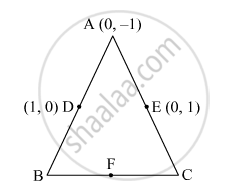Advertisements
Advertisements
प्रश्न
In \[∆\] ABC , the coordinates of vertex A are (0, - 1) and D (1,0) and E(0,10) respectively the mid-points of the sides AB and AC . If F is the mid-points of the side BC , find the area of \[∆\] DEF.
उत्तर

Let the coordinates of B and C be \[\left( x_2 , y_2 \right)\] and \[\left( x_3 , y_3 \right)\] , respectively.
D is the midpoint of AB.
So,
\[\left( 1, 0 \right) = \left( \frac{x_2 + 0}{2}, \frac{y_2 - 1}{2} \right)\]
\[ \Rightarrow 1 = \frac{x_2}{2} \text { and } 0 = \frac{y_2 - 1}{2}\]
\[ \Rightarrow x_2 = 2 \text{ and } y_2 = 1\]
Thus, the coordinates of B are (2, 1).
Similarly, E is the midpoint of AC.
So,
\[\left( 0, 1 \right) = \left( \frac{x_3 + 0}{2}, \frac{y_3 - 1}{2} \right)\]
\[ \Rightarrow 0 = \frac{x_3}{2} \text{ and } 1 = \frac{y_3 - 1}{2}\]
\[ \Rightarrow x_3 = 0 \text{ and } y_3 = 3\]
Thus, the coordinates of C are (0, 3).
Also, F is the midpoint of BC. So, its coordinates are \[\left( \frac{2 + 0}{2}, \frac{1 + 3}{2} \right) = \left( 1, 2 \right)\]
\[\frac{1}{2}\left[ 0\left( 1 - 3 \right) + 2\left( 3 + 1 \right) + 0\left( - 1 - 1 \right) \right]\]
\[ = \frac{1}{2} \times 8\]
\[ = 4 \text{ square units } \]
And the area of \[∆\] DEF is
\[\frac{1}{2}\left[ 1\left( 1 - 2 \right) + 0\left( 2 - 0 \right) + 1\left( 0 - 1 \right) \right]\]
\[ = \frac{1}{2} \times \left( - 2 \right)\]
\[ = 1 \text{ square unit } \left( \text{ Taking the numerical value, as the area cannot be negative } \right)\]
APPEARS IN
संबंधित प्रश्न
A (3, 2) and B (−2, 1) are two vertices of a triangle ABC whose centroid G has the coordinates `(5/3,-1/3)`Find the coordinates of the third vertex C of the triangle.
Find the ratio in which the line segment joining (-2, -3) and (5, 6) is divided by x-axis Also, find the coordinates of the point of division in each case.
Determine the ratio in which the point (-6, a) divides the join of A (-3, 1) and B (-8, 9). Also, find the value of a.
Show that the points A(2,1), B(5,2), C(6,4) and D(3,3) are the angular points of a parallelogram. Is this figure a rectangle?
The line segment joining the points A(3,−4) and B(1,2) is trisected at the points P(p,−2) and Q `(5/3,q)`. Find the values of p and q.
Find the area of quadrilateral ABCD whose vertices are A(-3, -1), B(-2,-4) C(4,-1) and D(3,4)
Find the area of the triangle formed by joining the midpoints of the sides of the triangle whose vertices are A(2,1) B(4,3) and C(2,5)
If the point A(0,2) is equidistant from the points B(3,p) and C(p, 5), find p.
Show that the points (−2, 3), (8, 3) and (6, 7) are the vertices of a right triangle ?
The co-ordinates of point A and B are 4 and -8 respectively. Find d(A, B).
If A(−3, 5), B(−2, −7), C(1, −8) and D(6, 3) are the vertices of a quadrilateral ABCD, find its area.
If R (x, y) is a point on the line segment joining the points P (a, b) and Q (b, a), then prove that x + y = a + b.
If the area of the triangle formed by the points (x, 2x), (−2, 6) and (3, 1) is 5 square units , then x =
The length of a line segment joining A (2, −3) and B is 10 units. If the abscissa of B is 10 units, then its ordinates can be
The ratio in which the line segment joining P (x1, y1) and Q (x2, y2) is divided by x-axis is
The line segment joining the points (3, -1) and (-6, 5) is trisected. The coordinates of point of trisection are ______.
The point at which the two coordinate axes meet is called the ______.
Find the coordinates of the point which lies on x and y axes both.
Co-ordinates of origin are ______.
